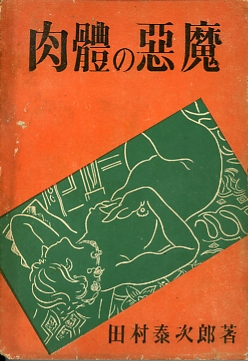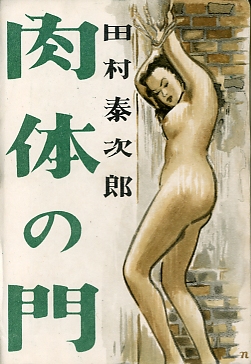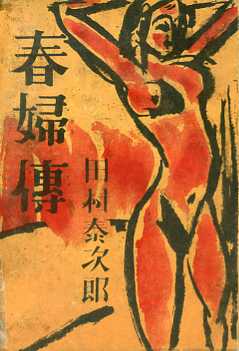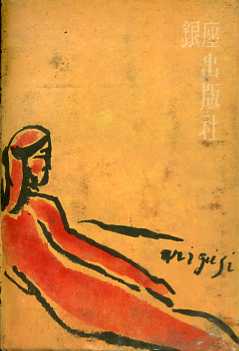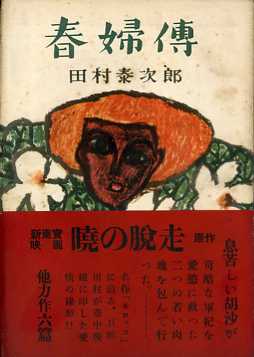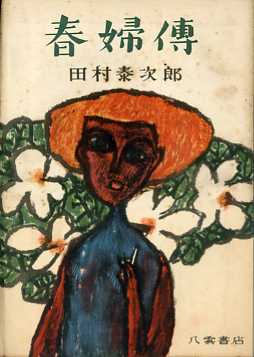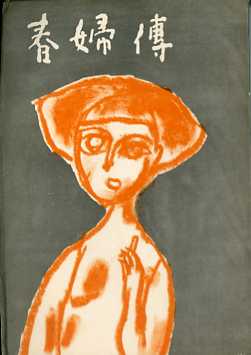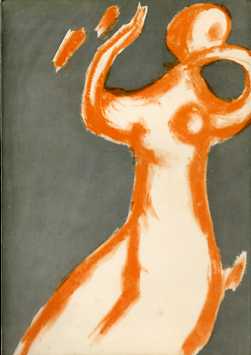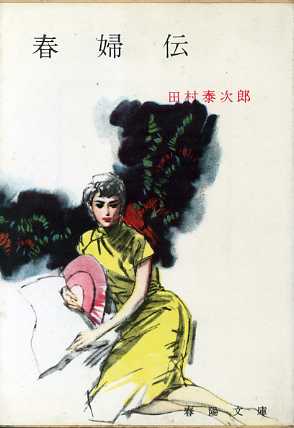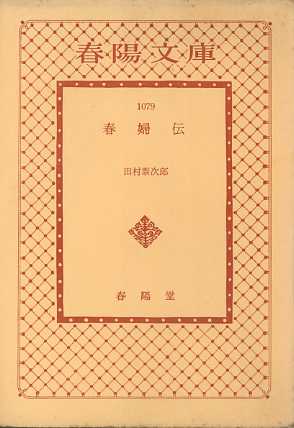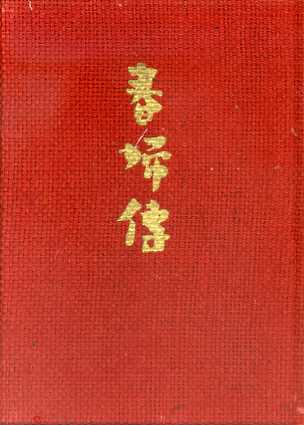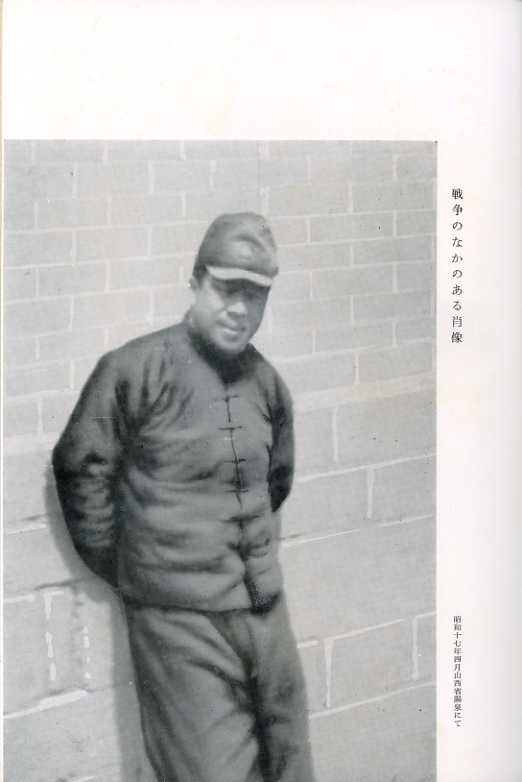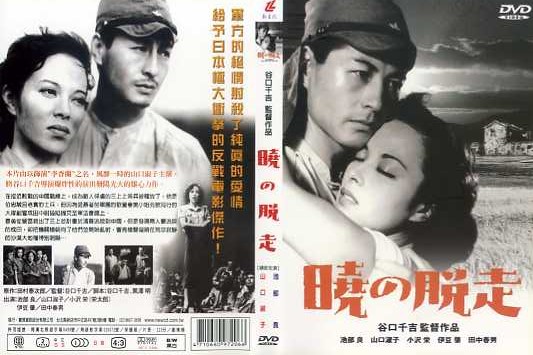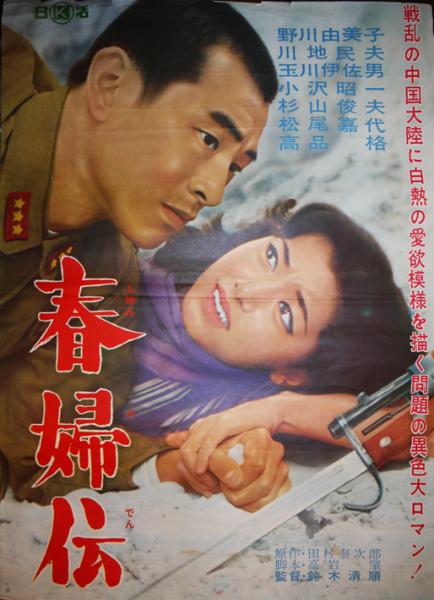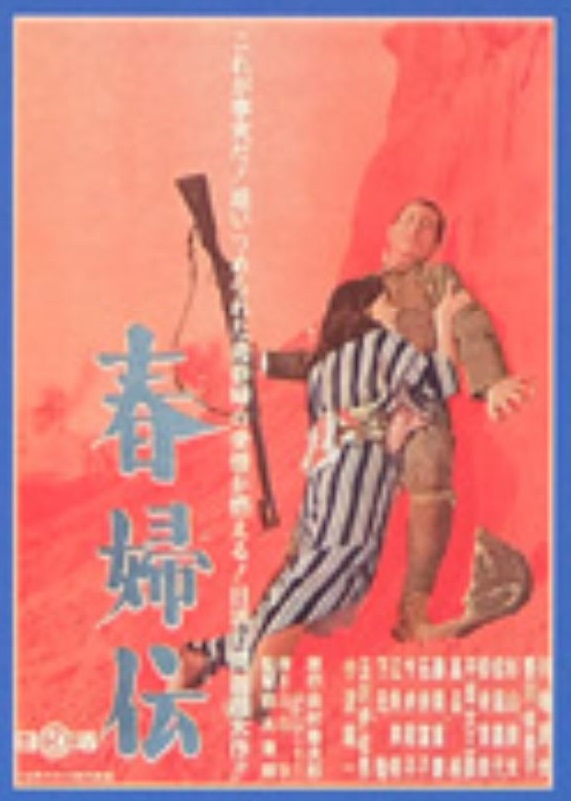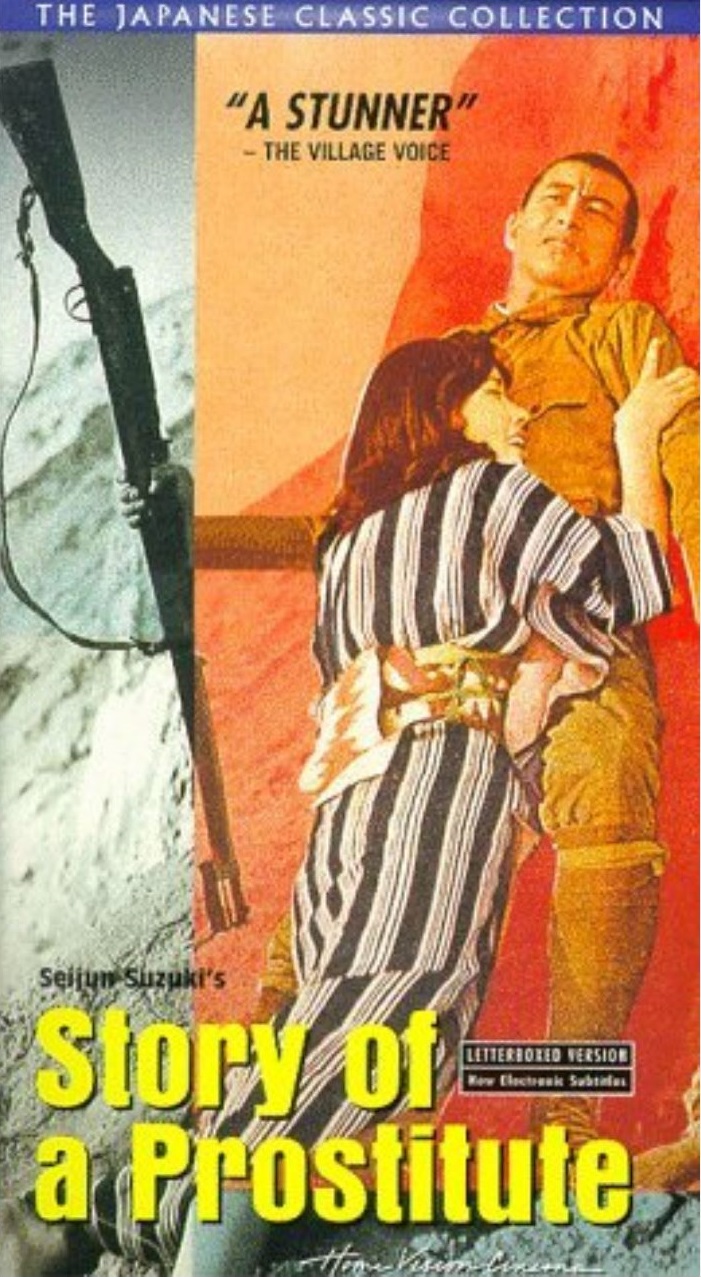Tamura Taijiro's Shunpuden
The life of a Chosenese "spring girl" in wartime China
By William Wetherall
First drafted 23 December 2014
First posted 28 August 2015
Last updated 26 August 2023
Shunpuden
Tamura Taijirō
•
Shunpuden editions
•
Wartime setting
•
Original story
•
GHQ/SCAP suppresses original
•
Kerkham on censorship
•
Sato on censorship
•
Kawasaki on Shunpuden
Carnality in action
Tamura's praise of Chosenese women
•
Flesh trumps race (and love conquers all)
"Would the Emperor call me a whore?" Harumi's "racial backhand" against Japanese who made a fool of her
Shunpuden in comfort women lore Kaibara Hiroshi's lampoon of Hirohito's ianfu
Shunpuden films
Akatsuki no dassō (1950) "Escape at Dawn"
•
Shunpuden (1965) "Story of a Prostitute"
Related articles
"Comfort women" or "sex slaves"?
Accurate history v. ideological exaggeration and denial (17 + 3 articles)
Aso Tetsu 1939 and Amako Kuni 2010
Medical and other measures for venereal disease prevention in the military
Tamura Taijirō's "Shunpuden" (1947)How the life of a wartime "spring girl"
|
Tamura TaijiroCarnality in wartime China and postwar JapanTamura Taijirō (�c�����Y 1900-1983), born and raised in Kōchi prefecture, was educated in literature at Waseda University. He was active in literary circles, and was earning his living as a novelist and writer, when the conflict between Japan and China -- later called a war -- broke out in 1937. In 1938 Tamura visited China, and the next year he visited Manchuria and northern China with other writers, who wrote about their observations and experiences in these areas. Many literary figures worked during the war years as journalists attached to Japanese military units. Tamura himself was drafted in 1940 and spent the rest of the war in Shanhsi, the setting of Shunpuden. He was involved in combat and was also once captured. He had risen to the rank of sergeant by the time the war ended in 1945, but would not return to Occupied Japan until 1946. Tamura's first novel, Nikutai no akuma, or "Demons of flesh" (���̂̈���), is about the carnality he witnessed in northern China. It was serialized from September 1946 before being published in a soft cover edition with the low grade pulp in use at the time. The story involves a relationship between a Japanese soldier and a Chinese women who had been captured as a communist guerrilla. He protects her from the brutality of other Japanese soldiers until she is returned to her village. Tamura's most famous novel, Nikutai no mon, or "Gate of flesh" (���̖̂�), was published in May 1947. The novel has been the basis of four films and a TV drama as of this writing. The story involves a prostitution ring in postwar Japan, in which the girls agree never to sleep with a man for free, and never to sleep with a GI. Shunpuden, the topic of this article, also writen in 1946, was first published in May 1947, as the third of Tamura's "nikutai triology". Nikutai no mon immediately became a bestseller and was made into a film with the same title in 1948. Shunpuden followed as a film titled Akatsuki no dassō in 1950. As Japan was then under the control of the Allied Powers, the novels and the films were subject to prior inspection and censorship. Shunpuden and Akatsuki no dassō; were especially problematical for Allied censors on account of what GHQ/SCAP viewed as the "Korean problem" in Japan -- meaning the 600,000 or so Chosenese who had chosen to remain in Occupied Japan rather than be repatriated. Both Nikutai no mon and Shunpuden were remade into films, under these tiles, by Suzuki Seijun (��ؐ��� 1923-2017), in respectively 1964 and 1965. These films -- again especially Nikutai no mon -- became attracted a lot of attention on account of their themes. Today they are cult films, both in Japan and overseas, where they are widely available in sub-titled versions. Nikutai no akuma was the Japanese title of the 1923 novel Le Diable au corps [The devil in the body (flesh)] by Raymond Radiguet 1903-1923). The novel has been translated into Japanese numerous times, twice before the Pacific War, in 1930 and 1936, under the title Nikutai no akuma (���̂̈���). A French film version, released in France on 12 September 1947 and in Japan on 6 November 1952, became very popular in subtitled and dubbed editions. I would guess that Tamura, a literature student, borrowed the title of his novel from the Japanese translation of Radiguet's novel. Tamura's Nikutai no akuma has never been made into a film. Nikkatsu's 29 October 1877 release of Nikutai no akuma, in its Nikkatsu Porno series, was a Japanization of 's novel. | ||||||
Editions of "Shunpuden" in Yosha BunkoTamura's nikutai triology -- especially Nikutai no mon, has been published in many single volume editions and numerous 1947 Ginza Shuppansha edition�c�����Y Tamura Taijirō 1949 Yakumo Shoten edition�c�����Y Tamura Taijirō 1962 Shun'yōdō Shoten bunko edition�c�����Y Tamura Taijirō 1965 Tōhōsha boxed edition�c�����Y Tamura Taijirō The 1947 Ginza Shuppansha edition is a collection of 8 stories, beginning with the cover story, the novella Shunpuden (pages 1-69), by far the longest story. The 1949 Yakumo Shoten edition also had 8 stories, beginning with Shunpuden (pages 5-73), followed by the second story in the 1947 Ginza Shuppansha collection. All 6 other stories are different. The 1962 Shun'yōdō Shoten bunko edition includes 5 stories in addition to Shunpuden (pages 1-48), all of them different from the stories in the earlier anthologies. The 1965 Tōhōsha edition features Shunpuden (pages 5-57) with 7 stories not in the earlier editions, including Nikutai no akama (1946), the first of his "nikutai triology", the second being Nikutai no mon and the third Shunpuden, all written in 1946 immediately after Tamura returned to Japan from China. The frontispiece of this edition is captioned "A portrait during the war" which is said to show Tamura at Yangch'üan (Yangquan) in Shanhsi (Shanxi) province. Movie tie-inTōhōsha's 1 February 1965 publication of the slip-cased Shunpuden anthology edition was timed for Nikkatsu's 28 February 1965 release of Suzuki Seijun's film version of Shunpuden. The anthology included Nikutai no mon, also directed by Suzuki, which Nikkatsu had released on 31 May 1964. Nikutai no mon was hugely successful in theatres at a time when Japan's postwar film industry was at its peak, but beginning to feel the threat of the spread of television and the variety of television fare that would eventually force film companies to reduce their movie production from 1 or 2 a week to just a few a year, and force all but a few local movie theaters to close. Nogawa Yumiko (���R���q), born in Kyōto in 1944, though second billed in Nikutai no mon, stole the show with her sexy performance, and was cast as the heroine Hiromi in Shunpuden. Nogawa would go on to be a major film, TV, and stage actresses. Nogawa, as a woman's weekly magazine reported in February 1966, had only recently learned that she was a national of ROC, through her father, who had married a Japanese woman. She apparently naturalized on or about 21 November 1966. |
||||||||||||||||||||||||||||||||||
Wartime setting of "Shunpuden"
The action in Shunpuden unfolds during the period when Japan was at war in China but not with China -- at least from Japan's point of view, and apparently also ROC's perspective -- because neither country delared war on the other. ROC would declare war on Japan the day after Japan attacked Pearl Harbor in 1941, joining America's declaration of war on Japan. Japan didn't declare war on ROC, because in 1940 it had recognized another Chinese government, which declared war on the United States in 1943. So at the time of Shunpuden, Japan is not fighting China, but resistance forces, mostly communist units in the hinterlands of northern China.
The Marco Polo Bridge incident north of Peiping on 7 July 1937 sparked battles between Japanese and Chinese forces in northern China. These battles took place in and around Peiping, as Peking had been renamed in 1928 when Chiang Kai-shek moved the capital of China to Nanking.
Shunpuden opens in the port town of Tientsin, where Japan had a small garrison as part of its extraterritorial concession there. By 30 July 1937, Tientsin had fallen to Japan, though for a while Japan continued to respect other foreign concessions.
The three women featured in Shunpuden had been working for a brothel in Tientsin, and were probably there from before the time Japanese troops took control of the city.
By the middle of August, Japanese forces were embroiled in hostilities in southern China, and on 12 November they controlled Shanghai, from which they pursued Chinese forces fighting defensive battles in retreat up the Yangtze river. By 13 December the Chinese capital at Nanking had fallen, and by 25 October 1938, Japanese forces controlled Wuhan, halfway of the Yangtze between Shanghai and Chungking (Chongqing), where Chiang Kai-shek had set up his government in exile.
Neither Japan or ROC declared war on the other country at that point. Japan ignored ROC's government in exile and worked instead with Chiang Kai-shek's former ally, now rival, Wang Ching-wei, to secure a constructive alliance between Japan and China.
On 30 March 1940, Japan sealed an agreement with Wang Ching-wei, who after ROC's government fled to Chungking had established his own nationalist government in the belief that China would suffer less by not fighting Japan. However, Japanese forces in the hinterlands of China continued to face mostly sporadic, though at times intense resistance from Chiang's nationalist forces and Mao Tse-tung's liberation army -- which had been fighting each other before Japan's incursions, but agreed to a truce in order to resist Japan.
The main action in Shunpuden takes place at a forward Japanese army base in Yu county (�) in Shanhsi (Shanxi, Shansi) province (�R����). The county was at the front between Japanese units and guerilla bases. Japanese forces had invaded Shanhsi province shortly after the start of hostilities in northern China in the summer of 1937. Shanhsi was a stronghold of anti-Japanese resistance, and Japanese forces continued to carry out retaliatory actions against guerillas from Japan's bases in Shanhsi. Tamura spent most of the war years serving in the Imperial Army at bases in Shanhsi.
|
Yu county In 1995, four Chinese women from Yu County filed law suits against the Japanese government. They claimed they had been abducted and raped and made to work as comfort women by Japanese soldiers and demanded reparations and an apology. Three similar lawsuits followed. By 2011, all suits had been dismissed. Some of the judgments recognized the allegations but ruled that applicable laws did not permit judicial relief. The courts held that the women had no legal right to compensation, because Japan and the People's Republic of China (PRC), when normalizing their relationship in 1972, had agreed that all grievances were settled, and because of statutes of limitations.
|
Original story of "Shunpuden"
Shunpuden is set at a brothel attached to a Japanese Imperial Army unit in China. The original story features Harumi (�t��) from Heijō (���� P'yŏngyang), and Yuriko (�S���q) and Sachiko (�����q) from Heian Kokudō (�����k�� P'yŏng'an Pukto), both parts of presentday DPRK. Harumi's name -- "spring beauty" -- virtually declares that she is the heroine.
The original version, which has never been published, contained a number of direct references to Chōsen, as well as the above place names. The revised published versions do not mention Chōsen, or the names of the women's home provinces, but other references make it clear that they are probably Chosenese.
|
The name Harumi is best known today as that of the singer Miyako Harumi (�s�͂��). She was born Ri Chunmi/Harumi (���t��) in 1948 the daughter of a Chosenese father and Interior mother, in Occupied Japan, where under Japanese and Allied Occupation law they were Japanese. Miyako and her family lost Japanese nationality in 1952 with other Chosenese and Taiwanese, and she naturalized in 1966 as Kitamura Harumi (�k���t��), thus adopting her mother's family name. This was a year after Japan and the Republic of Korea normalized their relationship and signed a status agreement according to which Japan officially recognized ROK nationality. Most Chosenese in Japan eventually migrated to ROK nationality, but a few thousand -- including those born and raised in the prefectural Interior after Japan's surrender, and after the status agreement came into effect in 1966 -- remain Chonenese. The alien status of "Chosenese" in Japan today remains a legacy post-colonial status unrelated to either ROK or its rival for Chosenese loyalty, the Democratic People's Republic of Korea (which really translates "People's Republic of Chosŏn"). For more about Miyako Harumi and other Chosenese and Korean public figures in Japan, see Public Figures in Popular Culture: Identity Problems of Minority Heroes in the Minorities section of Yosha Bunko. For more about "Chosenese" as a post-colonial legacy status, unrelated to ROK or DPRK, see Zaitokukai and the Japanese roots of Zainichiism: Special Permanent Residents as a caste of descendants of former Japanese, also in the Minorities section. |
The three girls who appear from the opening of Shunpuden had been sold to a brothel in the port town of Tientsin (�V�� Tianjin) by their parents, in what was then a fairly widely practiced and legal form of indentured servitude pretty much throughout East Asia. Harumi had fallen in love a Japanese man named Arita Kan'ichi (�L�c���s), who operated a flower company. She was attempting to pay off her debt, to marry him, when he returns to the Interior and comes back to Tientsin with a Japanese wife.
Tamura characterized the girls a having been "born "
Harumi and the other two girls then volunteer for work at a brothel being set up for an Imperial Japanese Army battalion encamped at a town in a neighboring inland province. The station is under military control, and Harumi and the other girls find themselves servicing lower ranking soldiers by day and officers by night. Harumi falls in love with Private Mikami Masayoshi, but has to tolerate forceful demands by his commanding officer, Aide-de-Camp (Lieutenant) Narita. A series of events results in Mikami being confined by Narita. Mikami asks Harumi to steal a grenade from Narita to help them escape, and when she realizes he plans to kill himself, she joins him in death. Yuriko and Sachiko cremate Harumi and scatter her ashes, not knowing her real name.
GHQ/SCAP suppresses original version of "Shunpuden"
The earliest version of Shunpuden that Tamura presented for public consumption appears in the galleys for the April 1947 inagural issue of the literary magazine Nihon shōsetsu. Tamura's story headed the list of several stories by various writers, some better known or more highly acclaimed than he.
The galleys of the April 1947 issue of the magazine were "submitted [for approval of publication] in January 1947 to the book section of the Press, Publications, and Broadcasting (PPB) of the Civil Censorship Detachment (CCD)" and hence Shunpuden had to have been written in 1946 (Kerkham 2001: 323-324). More specifically, they were submitted to "the Press-Publications unit of the Press, Publications and Broadcasting [sic = Broadcast] Division (PPB) of the Civil Censorship Detachment (CCD)" (Kerkham 2001: 335).
A copy of the suppressed galleys survives in the Gorden W. Prange Collection at the University of Maryland, and related documents. Prange (1910-1980) was a professor of history at the University of Maryland before the Pacific War and returned to the university after serving in the US Army from 1942-1951. He was stationed in Occupied Japan, during which time he served as General MacArthur's (SCAP's) Chief Historian. After returning to his professorial post, he wrote several books about the war, based on the primary sources he had collected, and the interviews conducted with Japanese military officers and others during his stay in Japan.
Civil Censorship Detachment (CCD) had a Communications Division which monitored mail, telegrams, and telephone communications, and a Press, Publications [Pictorial], and Broadcast Division that examined newspapers, books, movies, and plays. CCD was closely overseen by military intelligence officers in G-2 in the Government Section (GS), which was the military component of General Headquarters, Supreme Commander for the Allied Powers (GHQ/SCAP). The Civil Communication Section (CCS) was responsible for helping rebuild Japan's radio, telephone, and telegraph infrastructure. The Civil Information and Education Section (CIE) was in charge of public information, education, religion, and other sociological and cultural matters. At the time, radio was the only electronic mass medium for disseminating public information and providing educational, entertainment, and cultural programs. The offices of both CCD and CIE were located in NHK's Tokyo headquarters building, which GHQ/SCAP had requisitioned for the purpose of using radio to help democratize Japan. NHK was then Japan's principal radio broadcaster. It would not begin its television services until 1955, three years after the end of the Allied Occupation.
Eleanor Kerkham on censorship of "Shunpuden"From "HOLD" to "SUPPRESS"The most valuable examinations of GHQ/SCAP's censorship of Shunpuden in English, based on an examination of original documents in the Gorden W. Prange Collection at the University of Maryland, have been made by Eleanor Kerkham, a now retired professor of Japanese literature at the University of Maryland. Kerkham 2001Eleanor Kerkham Kerkham 2013Eleanor Kerkham Mayo's introductionWar, Occupation, and Creativity is a conference book, and as such it is a bit of a mixed bag. On the whole it is well edited but not all contributions are of equal quality. Editor (and contributor) Marlene J. Mayo leads her "Introduction" like this. IF RECENT DECADES HAVE TAUGHT US nothing else in the twentieth century, they have forced us to concede that no statement is a neutral statement; no art, however pure, can be created or understood apart from the politics of its time. Conversely, the real significance of those some politics, sometimes half-hidden, can often find distinctive and revealing reflections in the arts. If taking Mayo at her word, then her own statement lacks neutrality, and it has to be understood in terms of contemporary politics. The statement established a foundation for the generally "critical" approaches that, by the end of the 20th century, had taken root in American studies of Imperial Japan. Most contributions are jargon free, and their contributors appear to strive for a high level of "objectivity". Closer readings of their remarks, however, suggest that their "objectivity" is somewhat filtered through the fashionable ways academics had come to understand East Asia history during Japan's imperial years. Mayo's introduction, on "Japan's cultural imperialism in eastern Asia", is generally readable but there are some conspicuous errors. She speaks of "the fate of Japan's arts during the Allied Occupation (1945-1953)" -- which ended on 28 April 1952, never mind that, in some sense, Japan as still occupied by U.S. military bases (Mayo et al. 2001, page 2). Mayo also writes about Korea "In the confusion of liberation, division, and war (1945-1953)" -- as though to date the Korean war from 1945 rather than 1950 (et al. 10). Mayo characterizes Taiwan as having been "a prefecture of China when it was annexed in 1895" -- though Taiwan was not annexed by Japan, but was ceded to Japan as part of the settlement to the Sino-Japanese War of 1894-1895, which did not involve iwan. She says "Korea . . . was made into a protectorate in 1905, then appropriated in 1910" -- although Korea "joined" Japan in a "union" what amounted to Korea being annexed as Chōsen -- a word Mayo and other contributors avoid in favor of "Korea" (Ibid. 2). Articles touching on "Korea" and "Koreans" speak of "Korea" as though it was not part of Japan, and "Koreans" as though they were not Japanese", during the annexation years (1910-1945/1952). In fact, "Korea" ceased to exist in 1910 -- since which there has never been a "Korea" or "Koreans" in any objective political or demographic sense. What used to be "Korea" for the brief period of 13 years between 1897 and 1910, became "Chōsen" as part of Japan from 1910-1945/1952. Mayo's introduction does not get better. Every page has problems that could have been avoided by nuancing and fact checking. Mayo writes that Ri Kaisei, a "postwar Korean Japanese writer", was "born in Sakhalin in 1935 and relocated with his family permanently to Japan in 1947" (Ibid. 9). And a few pages later, she writes, "In addition to restoring Sakhalin, the Soviet Union descended upon the Kuriles as a prize of war for its belated entry" (Ibid. 20). Ri, however, was born in Karafuto, which was part of Japan, and a prefecture of Japan from 1943. His parents were Chosenese, hence Japanese, and so Ri himself was born Japanese. He was still technically of Japanese nationality when his family left Soviet occupied Karafuto for Occupied Japan in 1947, and he lost Japanese nationality with other Chosense in Japan in 1952. In 1875, Japan agreed with Russia that the southern part of Sakhalin, which Japan called Karafuto, would be Russian, in return for Russia's claim to the northern Kuriles, which Japan called the Chishima Islands. The southern Kuriles (southern Chishima) was already recognized as part of Japan. As part of the settlement in the Russo-Japanese War of 1904-1905, Russia ceded Japan the southern half of Sakhalin, which again became Karafuto, and also the northern Kuriles, which joined the southern Chishima islands as part of Hokkaidō prefecture. "Pleading for the Body"Mayo describes Kerkman's contribution to War, Occupation, and Creativity like this (Mayo et al. 2001, page 23). Eleanor Kerkham's essay on Tamura Taijirō is an exposé of wartime atrocities on two levels of denial, Americans and Japanese. as well as an exploration of constraints upon postwar Japanese literary creativity. Within the context of a rapidly excalating human rights issue long delayed in global consciousness until the early 1990's, she shows how a romanticized and yet, for its time, shocking literary indictment in 1947 of Japan's wartime exploitation of a Korean military comfort woman fell victim to American censors and to the author's own theories on sexuality in the new "literature of the body." [Note 59] Note 59 lists the "large and growing historical and journalistic work by Japanese, Koreans, Americans, and Australians on comfort women, with a special tribute tothe research talents of Japanese historian Yoshimi Yoshiaki, one of the first (1992) to discover official documentation of military sexual slavery" (Ibid. 41). Mayo's appraisal of Kerhkam's contribution as an "exposō" is accurate, in that it captures the tone of the pages that Kerkham devotes to contempoary (1990s) "comfort women = sex slaves" polemics. The tribute to Yoshimi Yoshiaki's 1992 book is telling, in that his book -- more than any other among the most cited Japanese-langauge reports -- presents documents which dramatize the diverse workings of what can be called the "comfort women system" -- so long as the "system" is recognized as having been subject to local conditions and local practices, and consequently was very complex. Yoshimi did not reduce "comfort women" to "sex slaves" -- although Suzanne O'Brien subtitled her 2015 English translation of his book "Sexual Slavery in the Japanese Military During World War II" and otherwise misrepresented or mistranslated some important parts of the book. Kerkham is fairly good -- sometimes very good -- at her overall assessment of how GHQ/SCAP (and others) ran interference in Tamura Taijirō's effort to publish "Shunpuden". She's done her homework on primary documents in the Prange Collection, and she's illuminated these documents rather well. She deserves a lot credit for that. What Kerkham does not do well is translate what Tamura writes, the way he writes it. It's Tamura's story, his voice, his phrasing, his metaphors. He had reasons, as a writer and novelist, for telling his story the way he wrote it. Kerkham in effect kicks Tamura out of the driver's seat and changes his words to those that were fashionable in 1990's American-style academic "critiques" of how Japan's postwar governments have responded to charges of "denialism" regarding Imperial Japan's involvement in "atrocities", such as its alleged complicity in orchestrating abductions of "Korean women" (i.e., Chosenese women) into "sexual slavery" at "comfort stations" deployed with Japanese military units in war zones and occupied countries. In short, while Kirkham is generally reliable when talking about GHQ/SCAP documents, which she has seen and effectively cites, her commentary on prewar, wartime, and postwar Japan suggests that is not very familiar with the conditions of Chosenese during the annexation years, or in Occupied Japan. And she seems to have swallowed the "comfort women = sex slaves" bait on the hooks of highly polemic publications in English, without herself having done the sort of homework she did to introduce Tamura's Shunpuden in the light of how it was viewed and treated by Allied Occupation censors, publishers, and the literary world. GHQ/SCAP censorhip of ShunpudenKerkham reconstructs the series of actions taken by GHQ/SCAP regarding the original galleys of Shunpuden. She reports that the "data sheet" attached to the galleys briefly described Shunpuden as follows (Kerkham 2001: 335). . . . depicts the tragic story of a Korean Prostitute who committed suicide with a Japanese soldier at the China front. At the same time, it emphatically illustrates the corruption of the former Japanese army. A two-page summary of the story attracted the attention of an officer who wrote -- "Leave this thing out! The mention of a Korean prostitute is dangerous, let alone the whole article." Kerkham points out his incorrect characterization of the "short novel" as an "article" -- suggesting that perhaps he misunderstood the intent of what he was reading. The officer -- according to Kerkham -- struck out "hold" and wrote "SUPRESS" on the 1st page, then stamped "SUPRESS" on the 1st page and on each of the other pages. However, the image of the 1st page, which she includes in her article, shows "HOLD" block-printed in upper case, crossed out with "Sup" written in cursive lower case above it -- and, immediately above this, in the margin at the top of the page, a "SUPRESS" stamp. The initial reason for the novella's suppression -- "incitement to violence and unrest". A later reason -- "criticism of Koreans". (Kirkman 2001: 335-336) Kerkham expands on this reasoning as follows (Kerkham 2001: 340-341). Highlighting and boxed comments mine.
Kerham goes not speculate about whether Tamura himself intended his story as a comment about the "military role" in the plight of the women he depicts in his story. She suggests that SCAP -- because of the use of Japanese women for the "'comfort' and recreation of American [sic = Allied] forces in Japan" [Note 97] -- was perhaps "not at all eager to have the topic of militarized prostitution become a 'public issue'" and hence resorted to the censorship category of "criticism of an ally" as a "more legitimate sounding" reason to suppress the work. Both reasons -- "incitement to violence and unrest" (bōryoku to fuon no kōdō no sendō �\�͂ƕs���̍s���̐���) and "criticism of Koreans [sic = Chosenese]" (Chōsenjin e no hihan ���N�l�ւ̔ᔻ) -- were listed on various "Key Logs" which had been issued by the end of 1946 to supplement the Code For Japanese Press issued on 21 September 1945 by the Civil Censorship Detachment of GHQ/SCAP's G-2 section. Kerkham on publication of May 1947 Ginza Shuppansha collectionKerkham makes the following observation, which suggests the extent to which opinion within GHQ/SCAP could vary -- as it did on other issues as well (Kerkham 2001: page 345, note 9). 9. Tamura Tajirō, Shunpuden (Tokyo: Ginza Shuppansha, May 1947), 1. The quote ["openly describing things which stagnated in my breast during the long war years"] is taken from the preface to a collection of stories featuring what appears to be a self-censored, "de-Koreanized" version of the short novel Shunpuden. This version did, to the later surprise of the magazine section, get past the Book Unit of the Press, Publications, and Broadcasting Division (PPB) of the Civil Censorship Detachment (CCD) and was published in May. The book published in May 1947 is the 1947 Ginza Shuppansha edition shown above and cited elsewhere in this article. |
Hiroaki Sato on censorship of "Shunpuden""Why did they bother?A more recent look at Shunpuden in English, by the New York based writer, translator, and critic Hiroaki Sato, was published in The Japan Times, to which he often contributes his takes on contempory and historical issues. Hiroaki Sato Sato made the following remark about the title assigned Shunpuden by GHQ/SCAP censors.
"Alluring" is Sato's way of representing the erotic and carnal nuances of "spring" (shun �t) -- as used in expressions like "selling spring" (baishun ���t) and "spring picture" (shunga (�t��), respectively the selling of one's body for sexual pleasure, and woodblock prints depicting sexual intercourse. Like many translators, Sato prefers to replace the perfectly good Japanese metaphor "spring" used in a romantic carnal context -- with "alluring" -- which replaces the metaphor with an interpretation or explanation. "shun""Shun" is here best translated "spring" -- in view of the fact that the protagonist's name is "Harumi" (�t��), meaning "spring beauty". The erotic associations of "spring" are clear enough in context. "fu/pu"Whether "fu" (�w) as "pu" should be translated "woman" or "women" is a toss. I am inclined to prefer "women" because the story -- while concerned mainly with one "shunpu" -- is about several if not all such women. Having said this, singular "woman" does underscore Harumi as the heroine. "shunpu"Kerkahm glosses "shunpu" as follows (Kerkham 2001: 335). Tamura's fictional vision is colored not only by his nikutai theory but also by a fantasy that he and other contemporary Japanese government officials and former military men have used to justify their own actions and attitudes -- that these women were "prostitutes" (the term "shunpu" in Tamura's title is literally "woman of spring" or "sex woman"). The characterizations of the "spring woman" in Tamura's story as a "sex woman" and "prostitute" are Kerkham's, not Tamura's. In his longer dedication to Shunpuden in the May 1947 Ginza Shuppansha edition (see below), as well as in the narrative of his story, Tamura puts the girls who served in the "women's army" above the "prostitutes of Japan" who stayed in the rear to cavort with the officers and disparage the rank-and-file soldiers and the women who lived and died in the fighting. Why all the fuss?As Kerkham describes the revisions to the original story, both those that appear to be have been inspired by GHQ/SCAP's suppression, and those that seem to have been motived by self-censorship, the modifications involve mostly the elimination of direct references such as "Korea" and "Korean" -- by which she has to mean "Chōsen" and "Chosenese", since "Kankoku" and "Kankokujin" did not exist and Tamura wrote only of "Chōsen" and "Chōsenjin". Kerkham also cites expressions like "women who loved garlic and hot red peppers" -- and adds, "key terms such as race, personal names, or foods" among other things that might suggest Chōsen or Chosenese. Sato, though, raises a question that Kerkham didn't ask (Sato 2014).
As I pointed out at the outset of this article, the title Shunpuden would probably have congered of recollections Shunkōden" to all 1947 readers familiar with Chosenese literature -- and that would have included quite a few Japanese in the prefectural Interior who were savvy about Chōsen and familiar with Chunkōden as a classical Chosenese romance. In fact, the story of Shunkōden was favorably dramatized in the Interior in 1938, and continued to be publicized by reprintings and even a bunko edition of Chō Kakuchū's play into the early 1940s. See Cho Kakuchu, Shunkoden, 1938, also in this Literature section, for details. |
Carnality in action
Although Shunpuden does not use the word "nikutai" (����) -- "body" or "flesh" -- in its title, it counts as the 3rd work of Tamura's "nikutai triology" on the grounds that he clearly articulates his "nikutai doctrine" at the start of the story, as well as in the forward he wrote for the version first published in May 1947 by Ginza Shuppansha.
Tamura's praise of Chosenese women
Tamara praised Chosenese women like those he portrayed in Shunpuden in at least two introductions he wrote for the story. I have translated the entirety of the shorter dedication he made in the original version of the story, which survives only in a copy of the galleys, and the first and most relevant part of his preface to the May 1947 Ginza Shuppansha edition. The 1949 and 1962 editions have no introductions, and the foreward to the 1965 edition -- a movie tie-in anthology -- does not especially concern the women in Shunpuden.
Tamura's dedication of Shunpuden in suppressed galleys version
| Tamura's dedication in supressed galleys version of Shunpuden | |||||
|
The Japanese text is my transcription of the dedication shown at the top of the 1st page of Tamura's Shunpuden as shown in an image of page 24 of the galleys in Kerkham 2001 (page 337, Figure 29). The raw and polished structural translations are mine. Note that the parenthetic (���) (Author) at the end has been struck out on the galleys, presumably by the editors of the magazine that had positioned Tamura's story first among several short stories in magazine. The sources of Kerkham's and Sato's versions are shown below (see source details above). All [bracketed remarks] are mine, except in Kerkham's translations, where they are hers. All highlighting and related comments are mine. |
|||||
Original text (Tamura Taijirō)���̈�т��A�푈�ԑ嗤���n�ɔz�u����ꂽ���{�R�������m�����Ԉ��̂��߁A���{���������|���j���Ƃŋ߂Â����Ƃ��Ȃ���������őO������g���A������t�Ɠ�铂Ƃ�S�ڂ��������������N���q�R�ɂ������B(���) |
|||||
Raw structural translation (William Wetherall)I dedicate this piece (work, story) to the Chōsen girls' (women's) army of tens of thousands, [who] for the comfort [of] the Japan Army lower-ranking soldiers [who] during the war had been deployed in the hinterlands of the continent, offered [volunteered] themselves, and ruined [and] left (wasted away) their youth and flesh, at all most (utmost, very) front lines that the women of Japan out of fear and contempt did not try to to approach. (Author) |
Polished structural translation (William Wetherall)I dedicate this story to the Chōsen women's army of tens of thousands, who for the comfort of the lower-ranking soldiers of Japan's army deployed in the hinterlands of the continent during the war, offered themselves, and wasted away their youth and flesh, at all the utmost front lines, which the women of Japan, out of fear and contempt, didn't try to approach. (Author) |
||||
Eleanor Kerkham (2001: 311)I dedicate this story to the tens of thousands of Korean women warriors [Chōsen joshigun] who, to comfort ordinary Japanese soldiers deployed to the Asian mainland during the war, risked their lives on remote battlefields where Japanese women feared and disdained to go, thereby losing their youths and their bodies [nikutai]. |
Hiroaki Sato (2014)This piece is dedicated to the tens of thousands of Korean Daughters who volunteered to every battlefront, which Japanese women would not approach with fear and contempt, in order to comfort the lowest-ranking soldiers of the Japanese Army deployed to the interiors of the Continent during the war, and who thereby destroyed their youth and bodies. |
||||
"tens of thousands"Of interest here is Tamura's "tens of thousands" as a description of the size of the "Chōsen women's troop". What was his basis for this estimate? Having directly observed conditions in parts of China where he was deployed, and with some idea of the total deployment of Imperial Japanese military units in China, he seems to have thought that "tens of thousands" was a reasonable number. Given Tamura's feelings about the war and the conditions he experienced in China, my guess is that he would be inclined to exaggerate more than underestimate. This is certainly the tendency among "sex slave" publicists today, who cite hundreds of thousands of abducted "Korean" victims alone -- beginning at 200,000 on up. Tamura's figure favorably compares with the best objective estimates of the number of comfort women of all nationalities and subnationalities -- mainly in China, but also in Southeast Asia and Manchoukuo -- as around 20,000, maybe 30,000, possibly but probably not 50,000. See "Comfort women" or "sex slaves"? on this website for details. Similar "hitoketa" (multiple-of-ten) discrepancies are seen in claims about "Nanking massacre" victims (30,000-50,000 against 300,000) -- and, say, the numbers of "GI babies" born in Occupied Japan (10,000-20,000 against 200,000). Comments on my translationhinterland is my preference for "okuchi" (���n), which is metaphorically a "back land" in the sense of a place that is deeper in the more remote bowels of country as seen from its capital, larger cities, or coastal ports. The term "naichi" (���n) is metaphorically an "interior land" of a country viewed from its coasts, ports, or peripheral territories, or outlying islands. In Imperial Japan, however, "Naichi" (���n) was also the formal name for the prefectural "Interior" jurisdiction of Japan, as distinct from (1) extraterritorial foreign settlements in Japan, and (Chōsen, Taiwan, and Karafuto (which joined the Interior as a prefecture in 1943). Furthermore, Chōsen, Taiwan, and Karafuto (before it joined the Interior) were informally regarded as "gaichi" or "exterior lands" relative to the Interior, although they were included with the Interior within "Japan" as a sovereign dominion, as distinct from territories that were legally under Japan's control and jurisdiction hence part of Japan's legal empire but not part of its sovereign empire. Tamura associates the soldiers (heitai ����), the women (josei ����), and the "girls' (women's) army (troop) (joshi gun ���q�R) with "Japan" (���{) and "Chōsen" (���N). If pressed to clarify himself, he might say that he meant they were "Japanese" (Nihonjin ���{�l) and "Chosenese" (Chōsenjin ���N�l) as "people" (jin �l), which the English "-ese" suffix implies when talking of people. If further pressed, he might say that he meant "people" in a racial rather than civil sense, though at the time Chōsen was an integral part of Japan and Chosenese were Japanese by civil nationality. Japanese law has never coded "race" or "ethnicity" and hence "-jin" (-�l "-person, -ese") suffixes in Japanese legal parlance denote only a civil status based on the territorial affifiliation of a person's domicile or household (family) register. In English-speaking circles, including those in which Kerkham and Sato were writing, people habitually use "Korea" as a generic term for the peninsula and/or a government on the peninsula, and "Korean" as the attributive form of "Korea" or noun meaning the people of Korea -- even during periods when "Korea" and "Koreans" did not exist. The Allied Powers also did this, though occassionally Allied documents stated "Korea (Chosen)" as though to remind people what "Korea" actually meant in the legal world. Today these distinctions are blurred or entirely lost, which makes it difficult to civil status issues then and even now -- and difficuult to talk about people who consider themselves "Kankokujin" (Korean) or (not and) "Chōsenjin" (Chosenese) or (not and) "Korian" (Chorean). offer oneself (teishin suru ��g����) means simply to contribute one's body (and soul) to a cause, to step forward on one's own volition and throw oneself into doing something -- i.e., to volunteer one's labor. Whether one volunteered out of a genuine desire to contribute to the cause is another matter. As in any human population, there was pressure to volunteer -- or one was volunteered by someone else. In time of war in particular, not to cooperate had consequences, from criticism, bullying, ostracization, to detention or even execution -- speaking not just about Japan but generally. Kerkham's "risk one's life" (see below) puts an interpretive spin on Tamura's expression rather than leave its meaning to the reader to consider in the larger context of the statement -- volunteering for work in a battle zone. Elsewhere, too, she at times "over translates" (and sometimes "under translates") Tamura's phrases. Comments on Kerkham's translationKerkham renders "Chōsen jōshigun" in the deleted introduction as "Korean women warriors" -- which technically mistranslates "Chōsen" as "Korean" and overtranslates "jōshigun" as "Korean women warriors" -- where as "Chōsen women's army" would be closer to Tamura's metaphors. Later, Kerkham morphs "women warriors" into "Amazon soldiers" in this comment (Kerkham 2001: 315). In the novel Shunpuden, Tamura depicts his three Korean "Amazon soldiers" as having been sold by their parents to what seems to be a privately owned brothel for Japanese army officers and civilians in the city of Tianjin, Hebei Province. [Note 31] Comments on Sato's translationSato makes a case for "daughters" as a translation of "jōshigun" (���q�R), which he points out is "niangzijun" in Chinese and originally "referred to the army of women that Tang Emperor Liyuan's daughter Gongzhu is reputed to have raised to help her father." The term "jōshi" (���q) is an older term for what today would generally by "joshi" (���q), as in "women's college" (joshi daigaku ���q��w). Today "jōshigun" is a used as a slang term for a group or gang of women in the metaphorical sense of "Amazons" -- women warriors. In the 19th century, however, "jōshigun" came to be used to refer to Japanese women who went to Southeast Asia and elsewhere in Asia to work as prostitutes -- otherwise called "karayuki-san" (���s����) or "those (-san) going (yuki) to a foreign land (kara) to work as prostitutes. Women going to the United States to work in places of entertainment that typically involved opportunities to sexually fraternize with customers were called "ameyuki", and foreign women coming to Japan to work in cabarets and clubs were later called "japayuki". See Prostitute and feminist: The story of Yamada Waka under "Japanese abroad / North America" in the "Minorities" section of this website for details. In other words, Tamura was probably familiar with "jōshigun" as a term referring to a group (troop, regiment) of woman from Japan working outside Japan as prostitutes. In association with the term "ian" (�Ԉ�) or "comfort" -- and later in the novel "iansho" (�Ԉ���) or "comfort station" -- "jōshigun" probably also implied that the women -- whether volunteers like Harumi, or indentured women bound by contracts to pay off a debt -- were more than just camp followers, but were somehow attached to military units, and at the mercy of the units for food, shelter, and transportation. The entry for "ianfu" in the 1st (1955) edition of Kōjien defines the term as ���Ɛ�n�̕����ɐ��s�A�������Ԉ������� meaning "Formerly a woman who followed [accompanied] a [military] unit in a battle area, and comforted officers and troops." The same edition defined �]�R as �R���ɏ]���Đ�n�ɕ������� meaning "Proceeding to (omomuku ����) battle area following military unit" and gave examples like �]�R�L�� meaning a "reporter following (attached to) the military" -- today's "embedded reporter". Only Tamura would know whether he had in mind an allusion to the "jōshigun" of Tang dynasty fame, or was using "jōshigun" mindful of only its more recent vernacular usage in Japanese. Personally, I suspect the latter. |
|||||
Tamura's preface to May 1947 Ginza Shuppansha edition of Shunpuden
| Tamura's preface to May 1947 Ginza Shuppansha edition of Shunpuden | |||||
|
The Japanese text is my transcription of the 1st paragraph of Tamura's 2-page foreword (jo ��) to the October 1947 Ginza Shuppansha edition of Shunpuden (Tamura 1947-05, Jo, page 1). The raw and polished structural translations are mine. The translation following these panels is Kerkham's (Kerkham 2001: 340). The [bracketed titles] in Kerkham's version are hers. All highlighting, other [bracketed remarks], underscoring, and comments are mine. |
|||||
Original text (Tamura Taijirō)�u�t�w�B�v�͌��e�p���S���̏�������i�ł���B�Dू̊ԁA�嗤���n�ɔz�u����ꂽ�������������m�����ƈꏏ�ɁA���{�R�̏��Z�₻�̏�w�����ł����������{�̏��w���������j�̂���Ȃ���A�e�̂Ȃ��ɐ����A������t�Ɠ�铂�S�ڂ��������q�R���ǂꂽ�� [sic = �ǂꂾ��] ���ɂɂ̂ڂ邾�炤�B���{�̏������͑O���ɂ��o�Ę҂��Ȃ������ɁA���Z�������ɂȂāA�������������m���j�̂����B�����ޏ��������q�R�ւ̋��������₤�ȕ��ƁA���{�̏������ւ̕��Q�I�ȟ����ł�����������B�u��铂̈����v�A�u��铂̖�v�Ɠ������A�����D�ꐶ���̂��Ђ��ɁA�����̋��̂Ȃ����T�ς������̂��Ԃ��܂������̂��B���̍�i�̏o�ҞĂ��ɂ��ẮA�����ȂƂ���܂������g�悭�킩��Ȃ��B�������́A�����̓�铂̂Ȃ����A���Əɉ��̓��Ђ����������߂�ꂽ�B���������ߒɂ̂����܂�̂₤�Ȃ���������̂��A�͂���Ɗ����Ă��B���͖����ŁA�����\�����悤�Ǝ��݂��ɂ����Ȃ��B |
|||||
Raw structural translation (William Wetherall)Shunpuden is a directly written [i.e., not serialized] work of 100-pages of manuscript paper. As for the women's army -- which during the war, together with we lower-ranking soldiers [who] were posted in the hinterland of the continent, while being disparaged by the officers of the Japanese Army and the prostitutes of Japan in the rear [who] were their paramours, lived in the middle of gunfire, and destroyed their youths and bodies -- how large would [its] numbers climb to. As for the women of Japan, despite not coming to the front, having become cohorts with the officers, disparaged we lower-ranking soldiers. I wrote this [story] with affection toward the girls' army such that [I] want to weep, and revengeful feelings toward the women of Japan. Like Nikutai no akuma [Demons of flesh] and Nikutai no mon [Gate of flesh], [Shunpuden is something in which I vented things that had pented up in my chest during [my] long battlefield life. Regarding the execution of this work, frankly I myself do not yet well understand [it]. [It's] just [that] as for me (It's just that I), [I] clearly feel that, in my own flesh, there is something like a lump of grief [sorrow, pain] that transcends reason [logic], that was fumigated and hardened by the smell of blood and nitrate smoke. As for me, absorbed [as in a dream] (in a daze), [I] [have] merely tried to express that. |
Polished structural translation (William Wetherall)Shunpuden is a directly written work of 100-pages of manuscript. The women's army -- which during the war, together with we lower-ranking soldiers posted in the hinterland of the continent, while being disparaged by the officers of the Japanese Army and the prostitutes of Japan in the rear who were their paramours, lived in the middle of gunfire, and destroyed their youths and bodies -- how large would its numbers climb to. The women of Japan, despite not coming to the front, having become cohorts with the officers, disparaged we lower-ranking soldiers. I wrote this with an affection toward the girls' army such that I want to weep, and revengeful feelings toward the women of Japan. Shunpuden, like Nikutai no akuma [Demons of flesh] and Nikutai no mon [Gate of flesh], is something in which I vented things that had pented up in my chest during my long battlefield life. Regarding the execution of this work, frankly I myself do not yet well understand it. It's just that I clearly feel, in my own flesh, that there is something like a lump of sorrow that transcends reason, that was fumigated and hardened by the smell of blood and nitrate smoke. I, in a daze, have merely tried to express that. |
||||
Eleanor Kerkham's translationDuring the war there were undoubtedly a great many women who sacrificed their youths and their bodies, while held in contempt by Japanese officers and the Japanese prostitutes serving as their war wives in the rear guard. They lived within the range of gunfire along with us lower-ranked soldiers stationed in the Asian Mainland. The Japanese women, assuming they must not go out to the battlefields, conspired with commissioned officers and despised ordinary, lower-ranked soldiers. I have written this story with a heart-wrenching longing toward those frontline women and with feelings of disdain toward the Japanese women. This is a work in which, just as in my Nikutai no akuma [Devil of the Flesh] and Nikutai no mon [Gateway to the Body], I have openly described things that stagnated in my breast during the long war years. To tell the truth, I cannot yet judge its literary quality. I have simply felt, with a clarity deep within my flesh and bones, that there was within me a dark, inchoate cloud of grief that smoldered unbearably with the scent of blood and gunpowder smoke. Dazed, like a man lost in a dream, I knew that I must try to put my feelings into words. [Note 94] Note 94 Tamura Taijirō, Shunpuden (Ginza Shuppansha, May 1947), preface, 1. |
|||||
Comments on Kerkham's translationKerkham's version is a very loose and embellished adaptation, not a translation. She seems to have no respect for Tamura's powerful phrasing and metaphors. Nothing he writes requires the paraphrasing, explanation, and commentary she swaps for his straight, simple, and perfectly pitched diction. Translation is not about language -- not about Japanese and English -- but about story and narrative. Translation requires accepting that the author is the story teller, and recognizing that the reader is smart enough to understand and appreciate the way the author tells the story. Comments on my translationwomen of Japan" Tamura does not call the prostitues who cavorted with the officers "Japanese women" but "women of Japan" -- which are obviously the "prostitutes of Japan" who are "paramours of the officers". This implies that the girls in the "women's army" are not "of Japan". In the original verious of Shunpuden, they were "of Chōsen" (Chōsen no ���N��). guru I have underscored guru (����) because Tamura stressed this expression with dot marks (bōten �T�_) beside the hiragana. Nikutai no akuma was first collected in an anthology of Tamura's stories published in April 1947. This was reprinted the following year when another published brought out another anthology that featured the novella as its cover story. I would guess that Tamura took the title of from the Japanese translation of Le Diable au corps (The Devil in the Flesh), the 1923 novel by Raymond Radiguet that set in the Great War. The first of several Japanese translations of Radiguet's novel was published as Nikutai no akuma (���̂̈���) in 1930. A second translation as Oni ni tsukarete (���ɜ߂����) [Possessed by the devil] came out in 1946, the year Tamura wrote his novella. A third translation bearing the compound title Nikutai no akuma: Oni in tsukarete (���̂̈����F���ɜ߂����) [The devil of flesh: Possessed by a demon] came out in 1952, when the first of several movie versions of the novel, a 1947 French production, was released in Japan. At least two other translations have since been published, both as Nikutai no akuma. nikutai Metaphorically, all appearances of "nikutai" (����) in Tamura's stories should probably be consistently translated "flesh". He uses other words, such as "shintai" (�g��), for body. The "body" is a corporal object, a vessel for the "flesh" that incarnates the body's carnal spirit as it were. Note that everything Tamura says about his own state of mind reflects his characterization of the "carnal" condition of the women's lives. His body, too, is driven by the emotions that originate and fester in his very flesh. |
|||||
Flesh trumps race (and love conquers all)If likeable like, if hateful hate, and no regretsThe human condition of the women in "Shunpuden" is essentially one of "carnality" -- meaning that every thing they do is determined by the "will" of their "bodies" or "flesh" -- depending on how one wishes to translate "nikutai" (����). As I stated above, I characterize Tamura's "nikutai-ron" (���̘_) as "nikutai doctrine". If pressed to fully anglicize the expression, I would render it "doctine of carnality". If pushed for an explanatory translation, I would go with "carnal determinism". Three pages into Shunpuden, following fast and dramatic establishing scenes, comes a long paragraph that essentially defines the geographical and socio-economic origins of the three women featured in the story. The paragraph also articulates Tamura's doctrine of carnality, according to which his characters live through the wills of their bodies or flesh. In her 2001 article on Shunpuden, Eleanor Kerkham translates the entire paragraph as it appeared in the galleys submitted to GHQ/SCAP for its approval in early 1947, with her notes and commentary. However, she divides her translation into two parts, one earlier and the other later in her article. And elsewhere in her article she comments on matters related to the original and revised versions of this paragraph. In the following table, I have first shown Kirkham's translation of the original version (left), followed by my transcription (center) and my structural translation (right) of the revised version of the paragraph.
|
||||||||||||||||||||
"Would the Emperor call me a whore?"Harumi's "racial backhand" against Japanese who made a fool of herKerhkam takes too many liberties in some of her summaries of Tamura's narrative. Rather than reveal what Tamura writes, and let readers participate in his 1940s drama, without her running 1990s Americnesque commentary -- in other words, rather than show before she tells -- she front loads her presentation with her own story, in the course of which she lifts things out of Tamura's story to suit her own viewpoint and purpose. And not infrequently she garbles the details. Kerham's overview of Harumi's comments about the emperor is a good example of what she does (Kerkham 2001: pages 318-319 and notes, all [bracketed remarks] and highlighting mine).
Tamura tells the story rather differently. Harumi quickly becomes very popular and everyone wants to play (asobu �V��) with her. The lieutenant who barges into her room in the following scene has only heard of her by reputation, but is determined to have his turn, even if it means pulling rank and breaking in line. Tamura uses "asobu" (�V��) in its totally conventional sense of "play" or "hang out" or "have fun" -- whether kids with toys in room or on a swing in a park, or high school students at a fastfood shop after school, or an office girl in bed with her married supervisor at a love hotel. My structural approach is to translated the word just "play" and leave its nuances to the reader. The word "yūjo" (�V��) is an old term in Japanese for "pleasure girl" while "playgirl" is "pureigaaru" (�v���C�K�[��). Midnight has come on the 5th night and someone pounds on Harumi's door so hard it seems it might break. The sergeant major, who was there for the night, is sleeping in her bed. She asks who's calling and says she has a guest. "I don't care, open up", the caller says and starts kicking the door. She can see his eyes peering through a space between the door and the frame. He kicks the door harder, calls her a fool, and worrying he'll break the door, she releases the catch and opens it herself. Harumi tries to block the door, but the tall officer pushes her aside and barges in. It was the lieutenant. He sees the man on Harumi's bed and orders him to get up. The sergeant, pretending he was asleep, opens his eyes and lifts his head from the pillow. The lieutenant recognizes him, and knowing he'd been permitted to stay the night, says, "You've already played, right? So change with me (mō, asondan daro, na, kawatte kure yo �����A�V��A�ȁA����Ă����). The sergeant's acknowledgment of the lieutenant's request was weak, but seeming resigned about it, he stands to leave. "Why are you leaving? You can't leave," Harumi says, taking his arm, while glaring at the lieutenant. "You leave (anta wa kaere yo ���͂������)," she says to the lieutenant. "I'm not playing with you." The narrator remarks that Harumi doesn't care if she's killed, she's not going to take the officer as a partner. (1947: 18-21, 1949: 22-24). The confrontation escalates like this (1947: 21, 1949: 24-25).
Shunpuden filmsThe 1st movie version, made in 1949 and released in 1950 by Shin Tōhō (�V����), corrupted the original story, beginning with its title, "Akatsuki no dassō" (�ł̒E��), or "Escape at Dawn" as it is generally known in English. The film was directed by Taniguchi Senkichi (�J����g 1912-2007) from a script he wrote with the help of Kurosawa Akira (���V�� 1910-1998). After squabbling over how to handle the Chosenese elements that remained in the novel, and the manner in which the lovers died, the film makers turned Tamura's story into a very different kind of drama. The 2nd film adaptation, made and released in 1965 by Nikkatsu (����) and directed by Suzuki Seijun (��ؐ��� b1923), attempted to return the story to its novelistic roots, but ended up corrupting it in different ways -- again without its original Chosenese elements.
| |||||||||||||||||||||||||||||||||||||||||||||||
